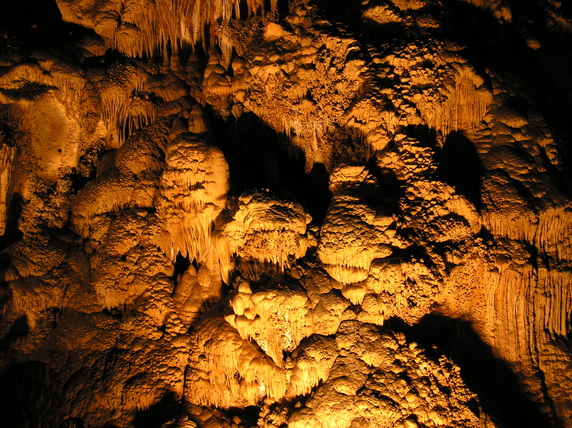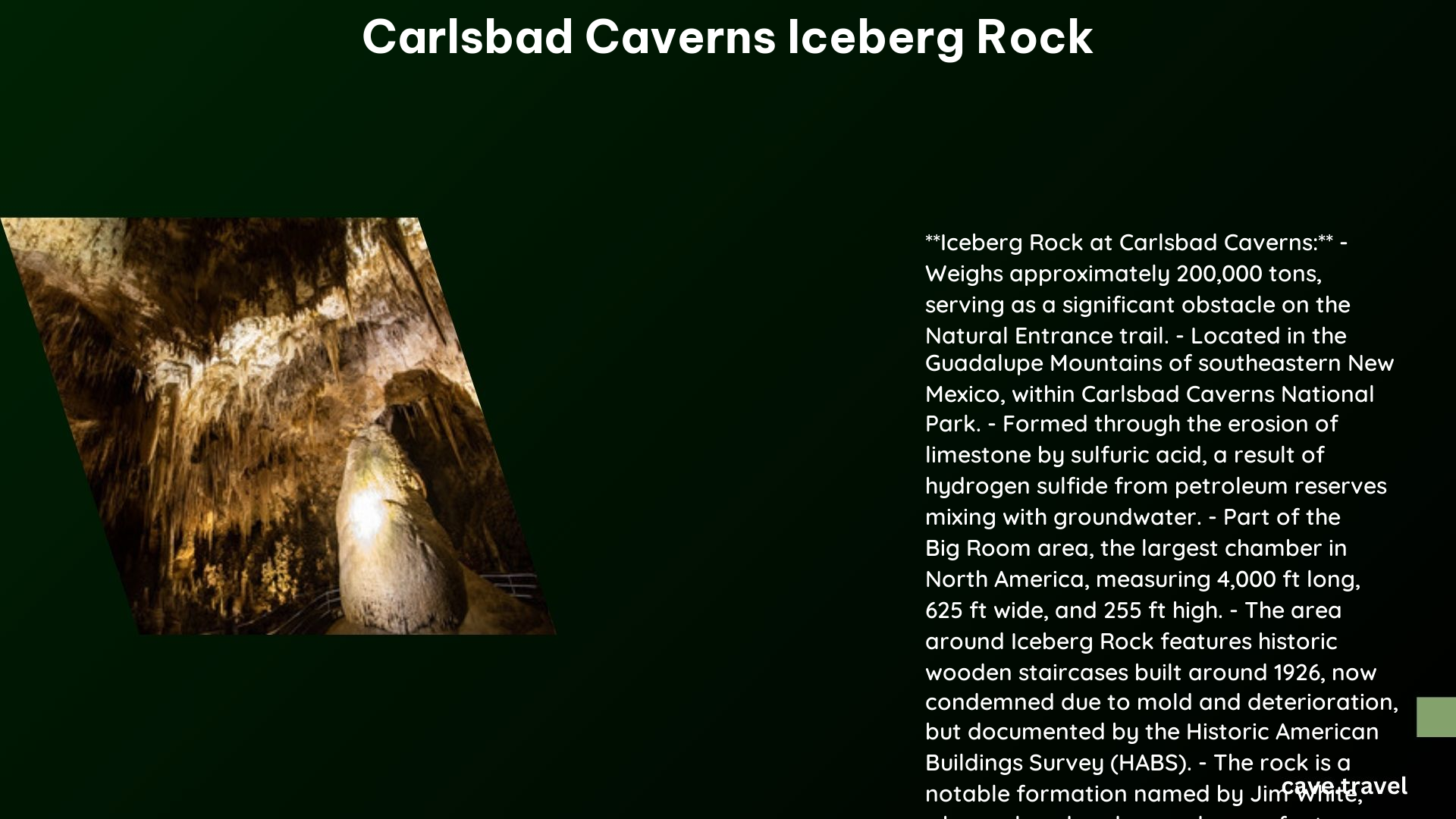Carlsbad Caverns Iceberg Rock is a massive geological formation within Carlsbad Caverns National Park. This colossal breakdown block, weighing over 200,000 tons and measuring 170 feet in length, fell from the cave ceiling approximately 513,000 years ago. It stands as a testament to the dynamic geological processes that shaped the caverns. Iceberg Rock is a focal point for visitors, offering a glimpse into the cave’s ancient history and the ongoing formation of stalactites and stalagmites.
What is the Geological Significance of Iceberg Rock?

Iceberg Rock holds immense geological importance within Carlsbad Caverns:
- Age: The rock’s fall occurred around 513,000 years ago, providing a timeline for the cavern’s development.
- Size: At 170 feet long and weighing over 200,000 tons, it’s the largest breakdown block in the cavern.
- Formation Evidence: The area above Iceberg Rock lacks travertine, indicating its original position on the ceiling.
- Speleothem Growth: Stalactites on the rock predate its fall (513,000 years old), while stalagmites formed after (180,000 years or younger).
This geological feature offers scientists valuable insights into the cavern’s formation processes and timeline.
How Can Visitors Access Iceberg Rock?

Reaching Iceberg Rock involves a journey through the cavern’s main trail:
- Enter through the Natural Entrance
- Descend approximately 700 feet via switchbacks and tunnels
- Follow the trail to the Big Room
- Locate Iceberg Rock within the Big Room area
Visitors can choose between self-guided tours or ranger-led experiences to explore this remarkable formation.
What Safety Measures Should Visitors Observe?
When exploring Iceberg Rock and its surroundings, visitors must adhere to these safety guidelines:
- Stay on designated trails at all times
- Avoid touching any cave formations
- Follow all park rules and ranger instructions
- Wear appropriate footwear for uneven surfaces
- Bring a light jacket (cave temperature is consistently 56°F/13°C)
What Are the Best Times to Visit Iceberg Rock?
To optimize your visit to Iceberg Rock, consider the following:
| Season | Advantages | Considerations |
|---|---|---|
| Summer | Longer daylight hours | Busier, potential crowds |
| Winter | Fewer visitors | Shorter operating hours |
| Spring/Fall | Moderate crowds | Variable surface weather |
The cavern is open year-round, except for December 25th. Check the official park website for current operating hours and tour availability.
How Does Iceberg Rock Contribute to Cave Ecology?
Iceberg Rock plays a crucial role in the cave’s ecosystem:
- Microhabitat Creation: The rock’s surface and crevices provide unique habitats for cave-dwelling organisms.
- Moisture Retention: Its large mass helps maintain humidity levels within the cavern.
- Air Circulation: The rock’s position influences air currents within the Big Room.
- Mineral Deposition: Ongoing formation of speleothems on and around the rock contributes to the cave’s mineral diversity.
What Photography Tips Can Enhance Iceberg Rock Captures?
To capture stunning images of Iceberg Rock:
- Use a tripod for stability in low-light conditions
- Experiment with long exposures to capture more detail
- Bring a wide-angle lens to encompass the rock’s massive size
- Utilize the cave’s lighting to create dramatic shadows and highlights
- Respect park rules regarding flash photography and tripod use
Remember to obtain any necessary permits for professional or commercial photography.
How Has Iceberg Rock Influenced Scientific Research?
Iceberg Rock has been instrumental in various scientific studies:
- Speleothem Dating: Stalactites and stalagmites on the rock have provided crucial data for cave chronology.
- Paleoclimate Research: Mineral deposits offer insights into past climate conditions.
- Geological Processes: The rock’s fall and subsequent formations illustrate cave evolution over time.
- Microbiology: Unique microbial communities on the rock surface are subjects of ongoing research.
These studies contribute to our understanding of cave formation, climate history, and subterranean ecosystems.
What Cultural Significance Does Iceberg Rock Hold?
Iceberg Rock has cultural importance beyond its geological value:
- Indigenous Perspectives: Native American tribes have traditional stories and beliefs associated with the caverns and its features.
- Early Exploration: The rock served as a landmark for early cave explorers and mappers.
- Tourism Icon: It has become a symbol of Carlsbad Caverns, featured in numerous publications and documentaries.
- Educational Tool: Rangers and educators use Iceberg Rock to illustrate geological concepts to visitors.
How Can Visitors Prepare for an Iceberg Rock Encounter?
To make the most of your Iceberg Rock experience:
- Book tours in advance, especially during peak seasons
- Wear comfortable, closed-toe shoes with good traction
- Bring a light jacket or sweater for the cool cave environment
- Carry water in a reusable bottle (no food allowed in the cave)
- Familiarize yourself with cave etiquette and preservation guidelines
- Consider joining a ranger-led tour for in-depth information
- Allow ample time to explore the Big Room and its features
By following these preparations, visitors can fully appreciate the grandeur of Iceberg Rock and its surrounding cave environment.
References:
1. https://npshistory.com/publications/cave/index.htm
2. https://www.youtube.com/watch?v=g9NFja7xWkg
3. https://www.nps.gov/cave/learn/nature/geologicformations.htm
